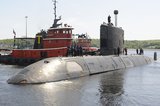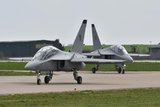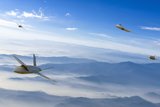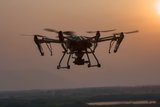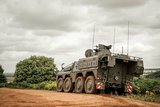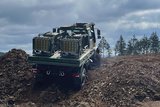CAE Perspective: Solutions for ISR Data Overload (sponsored)
This story is brought to you by CAE.
The challenge of ingesting, sourcing, collecting, aggregating, compiling and comprehending data to answer intelligence questions, assess the threat, and know the mind of the enemy, is a staggering one. It cannot be met through traditional approaches of manual data processing and analysis. It requires a better solution. Artificial Intelligence holds the key
In response to the challenge of information overload, the Intelligence Community and military services are developing all-source data fusion tools—powered by artificial intelligence and machine learning (AI/ML)—to search, triage, visualize, and link disparate structured and unstructured data in a geospatially referenced context.
These fusion tools are intended to help the analyst make better, faster, and more frequent judgments on the intent of the enemy and transform the disparate firehose of data into high-confidence assessments. Intelligence assessments depend on the processing of vast quantities of raw sensor data from all domains, to build a 3D picture of enemy activity, to answer the commander’s questions and predict the good, bad, and the ugly of impending military operations.
The job cannot be done by one human mind, or even a large team. The quantity of data is just too immense. Considering the problems of domain focused ISR collection (air, space, land, maritime, cyber), distributed operations, the organizational stovepipes of joint and coalition task forces and the complications of multi-level security, the need for automated data processing becomes even more compelling.
An immersive and coherent data environment is required, one that is comprehensible and explainable for the human analyst. This entails automation to put the right georeferenced data, in front of the right analyst, at the right time. A cybersecure, user-defined digital ecosystem is the answer. A system which sifts through, diverts, and then visualizes a mosaic of structured and unstructured data into something a trained analyst can instantly comprehend.
Rapid advancements in 3D modeling and simulation (M&S), digital technologies supporting immersive synthetic environment development, augmented reality (AR), and game engines are the catalysts to help achieve this goal.
A user-defined digital ecosystem could effectively bridge the written word (structured and unstructured) into a physical, augmented environment. This would enable the analyst to play out threat scenarios, use disparate information to show geospatial linkages, derive commonalities and differences, paint a picture for advanced assessments and analysis, and even provide reasoned insight into future conditions or situations.
Employing an immersive data environment leveraging AR, enabled by a robust methodological framework, intelligence analysts could visualize changes in the digital ecosystem defined for specifically defined needs, reducing the “fog” of military operations and assisting intelligence professionals to develop and refine the most accurate assessments and threat pictures.
Large investments in developing high-fidelity ISR sensor simulation, as part of aircraft tactical flight and multi-role strike training, enables high-fidelity sensor simulation models to be incorporated into large-force operations simulation. This immersive data environment, resulting from generation of the synthetic data needed to develop and refine the AI/ML tools for data processing, the AR tools for data visualization, and the tactics/techniques/procedures is the requirement to fuel the effectiveness of analysts.
Drawing upon both internally developed and commercially available tools, the physics-based virtual environment for tactical training events and the joint/coalition forces and targets can be represented in large-scale simulations. Red and blue forces can be created and placed into the virtual space, with automated, AI-driven behavior based on the scenario, to present the activity needed for ISR collection. Virtual sensor models create the synthetic sensor data (such as full motion video, high-level imagery, radar images, and electromagnetic signals) needed to stimulate the intelligence, targeting, and collection management processes and expedite the development of AI/ML tools.
To train the all-domain analyst of the near future, this same technology facilitates the presentation of complex, large-force military operations to exercise the entire Tasking/Collection/Processing/Exploitation/Dissemination (TCPED) process while continuing to refine the ability of AI/ML algorithms to conduct target recognition and analysis, as they would with live sensor feeds.
Rapid advancements in computing power and other technologies will not solve or advance intelligence analytic tradecraft. They do set the stage for full immersion and adoption of a digital ecosystem providing intelligence analysts with advanced tools for reducing the ambiguity, uncertainty, and improve the reliability of disparate data.
A data-centric approach, with its ability to generate the full spectrum of synthetic C2ISR data, and stimulate operational tools, provides key training, mission rehearsal, and operational assessment experience needed by ISR operators of the very near future.
Recent DoD and NATO large force exercises, such as the Coalition Warrior Interoperability Exercise (CWIX), have demonstrated the value of synthetic ISR data and the digital ecosystem to develop new AI/ML data processing capabilities. The CAE Virtual ISR Training Application (VISTA), a cloud-based set of M&S tools, has been used to provide this immersive, synthetic data environment for stimulation of the TCPED process.
Collaboration between industry, government, and tactical users is key to guiding these types of investments toward high-value solutions. Providing the right training, at the right time, to the right ISR professionals – effectively and efficiently - calls for a dedicated multidisciplinary team with the necessary expertise to integrate solutions to meet the complexities of military operations - today, and into the future.
For more information please click here.
More from Industry Spotlights
-
![The future is here: Sixth-gen air dominance]()
The future is here: Sixth-gen air dominance
How RTX is equipping the military airspace – for today’s fleet and tomorrow’s fight.
-
![De-Risking the Future: Manufacturing Certainty for Unmanned Systems]()
De-Risking the Future: Manufacturing Certainty for Unmanned Systems
How strategic manufacturing partnership solves the industrialisation triad — Scale, Compliance and Cost — for hyper-growth defence tech innovators.
-
![Battlefield mobility, made in the UK]()
Battlefield mobility, made in the UK
How does Britain ensure that we can preserve the lives of our soldiers and allies – now and in the future – with homegrown innovation and resilient domestic manufacturing? At Pearson Engineering, we are proud to be a central part of the answer to this increasingly important question.
-
![Strengthening Baltic defence capabilities]()
Strengthening Baltic defence capabilities
How Latvia is bolstering its territorial defences, industrial capacity and international cooperation with Dynamit Nobel Defence’s SKORPION2 Remote Mining System.
-
![Barco’s vision to trust: from past to future]()
Barco’s vision to trust: from past to future
Barco’s story is one of constant evolution enabling more immersive, reliable, and future-ready training experiences.
-
![How are next-generation ejection seats helping pilots when they need it most?]()
How are next-generation ejection seats helping pilots when they need it most?
The ACES 5 ejection seat from RTX’s Collins Aerospace introduces new, innovative and patented technologies to help save lives.









